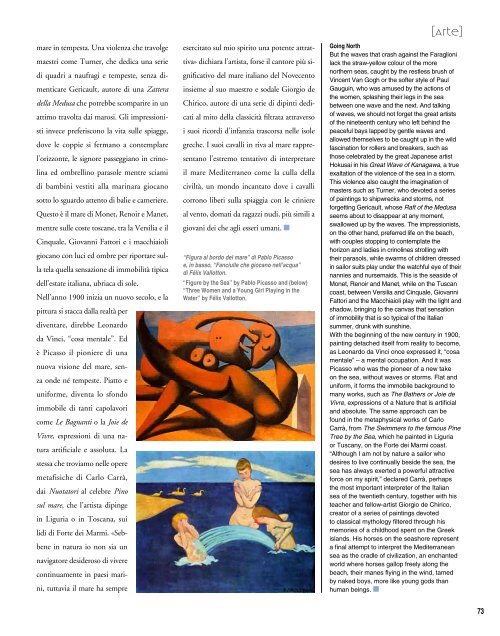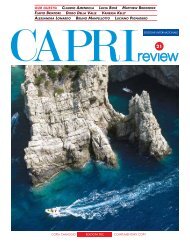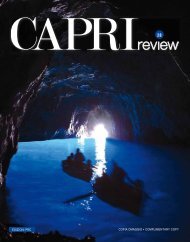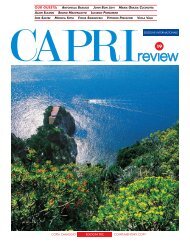Create successful ePaper yourself
Turn your PDF publications into a flip-book with our unique Google optimized e-Paper software.
mare in tempesta. Una violenza che travolge<br />
maestri come Turner, che dedica una serie<br />
di quadri a naufragi e tempeste, senza dimenticare<br />
Gericault, autore di una Zattera<br />
della Medusa che potrebbe scomparire in un<br />
attimo travolta dai marosi. Gli impressionisti<br />
invece preferiscono la vita sulle spiagge,<br />
dove le coppie si fermano a contemplare<br />
l’orizzonte, le signore passeggiano in crinolina<br />
ed ombrellino parasole mentre sciami<br />
di bambini vestiti alla marinara giocano<br />
sotto lo sguardo attento di balie e cameriere.<br />
Questo è il mare di Monet, Renoir e Manet,<br />
mentre sulle coste toscane, tra la Versilia e il<br />
Cinquale, Giovanni Fattori e i macchiaioli<br />
giocano con luci ed ombre per riportare sulla<br />
tela quella sensazione di immobilità tipica<br />
dell’estate italiana, ubriaca di sole.<br />
Nell’anno 1900 inizia un nuovo secolo, e la<br />
pittura si stacca dalla realtà per<br />
diventare, direbbe Leonardo<br />
da Vinci, “cosa mentale”. Ed<br />
è Picasso il pioniere di una<br />
nuova visione del mare, senza<br />
onde né tempeste. Piatto e<br />
uniforme, diventa lo sfondo<br />
immobile di tanti capolavori<br />
come Le Bagnanti o la Joie de<br />
Vivre, espressioni di una natura<br />
artificiale e assoluta. La<br />
stessa che troviamo nelle opere<br />
metafisiche di Carlo Carrà,<br />
dai Nuotatori al celebre Pino<br />
sul mare, che l’artista dipinge<br />
in Liguria o in Toscana, sui<br />
lidi di Forte dei Marmi. «Sebbene<br />
in natura io non sia un<br />
navigatore desideroso di vivere<br />
continuamente in paesi marini,<br />
tuttavia il mare ha sempre<br />
esercitato sul mio spirito una potente attrattiva»<br />
dichiara l’artista, forse il cantore più significativo<br />
del mare italiano del Novecento<br />
insieme al suo maestro e sodale Giorgio de<br />
Chirico, autore di una serie di dipinti dedicati<br />
al mito della classicità filtrata attraverso<br />
i suoi ricordi d’infanzia trascorsa nelle isole<br />
greche. I suoi cavalli in riva al mare rappresentano<br />
l’estremo tentativo di interpretare<br />
il mare Mediterraneo come la culla della<br />
civiltà, un mondo incantato dove i cavalli<br />
corrono liberi sulla spiaggia con le criniere<br />
al vento, domati da ragazzi nudi, più simili a<br />
giovani dei che agli esseri umani. <br />
“Figura al bordo del mare” di Pablo Picasso<br />
e, in basso, “Fanciulle che giocano nell’acqua”<br />
di Félix Vallotton.<br />
“Figure by the Sea” by Pablo Picasso and (below)<br />
“Three Women and a Young Girl Playing in the<br />
Water” by Félix Vallotton.<br />
[Arte]<br />
Going North<br />
But the waves that crash against the Faraglioni<br />
lack the straw-yellow colour of the more<br />
northern seas, caught by the restless brush of<br />
Vincent Van Gogh or the softer style of Paul<br />
Gauguin, who was amused by the actions of<br />
the women, splashing their legs in the sea<br />
between one wave and the next. And talking<br />
of waves, we should not forget the great artists<br />
of the nineteenth century who left behind the<br />
peaceful bays lapped by gentle waves and<br />
allowed themselves to be caught up in the wild<br />
fascination for rollers and breakers, such as<br />
those celebrated by the great Japanese artist<br />
Hokusai in his Great Wave of Kanagawa, a true<br />
exaltation of the violence of the sea in a storm.<br />
This violence also caught the imagination of<br />
masters such as Turner, who devoted a series<br />
of paintings to shipwrecks and storms, not<br />
forgetting Gericault, whose Raft of the Medusa<br />
seems about to disappear at any moment,<br />
swallowed up by the waves. The impressionists,<br />
on the other hand, preferred life on the beach,<br />
with couples stopping to contemplate the<br />
horizon and ladies in crinolines strolling with<br />
their parasols, while swarms of children dressed<br />
in sailor suits play under the watchful eye of their<br />
nannies and nursemaids. This is the seaside of<br />
Monet, Renoir and Manet, while on the Tuscan<br />
coast, between Versilia and Cinquale, Giovanni<br />
Fattori and the Macchiaioli play with the light and<br />
shadow, bringing to the canvas that sensation<br />
of immobility that is so typical of the Italian<br />
summer, drunk with sunshine.<br />
With the beginning of the new century in 1900,<br />
painting detached itself from reality to become,<br />
as Leonardo da Vinci once expressed it, “cosa<br />
mentale” – a mental occupation. And it was<br />
Picasso who was the pioneer of a new take<br />
on the sea, without waves or storms. Flat and<br />
uniform, it forms the immobile background to<br />
many works, such as The Bathers or Joie de<br />
Vivre, expressions of a Nature that is artificial<br />
and absolute. The same approach can be<br />
found in the metaphysical works of Carlo<br />
Carrà, from The Swimmers to the famous Pine<br />
Tree by the Sea, which he painted in Liguria<br />
or Tuscany, on the Forte dei Marmi coast.<br />
“Although I am not by nature a sailor who<br />
desires to live continually beside the sea, the<br />
sea has always exerted a powerful attractive<br />
force on my spirit,” declared Carrà, perhaps<br />
the most important interpreter of the Italian<br />
sea of the twentieth century, together with his<br />
teacher and fellow-artist Giorgio de Chirico,<br />
creator of a series of paintings devoted<br />
to classical mythology filtered through his<br />
memories of a childhood spent on the Greek<br />
islands. His horses on the seashore represent<br />
a final attempt to interpret the Mediterranean<br />
sea as the cradle of civilization, an enchanted<br />
world where horses gallop freely along the<br />
beach, their manes flying in the wind, tamed<br />
by naked boys, more like young gods than<br />
human beings. <br />
73







